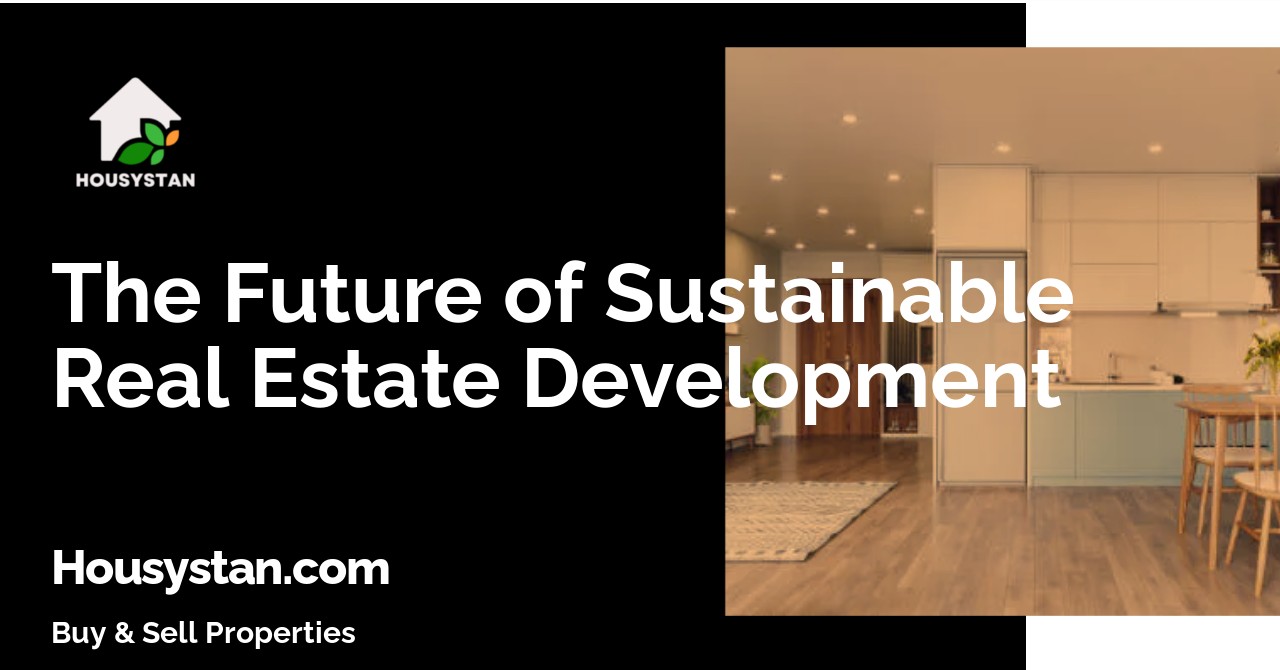The Future of Sustainable Real Estate Development
Read latest blogs and articles from Housystan

The Information mentioned here was last updated on:
18/12/2025The Future of Sustainable Real Estate Development
Sustainable real estate development is quickly becoming the cornerstone of modern urban planning. As the effects of climate change and environmental degradation become more pronounced, the construction and real estate sectors are transforming rapidly. This shift towards sustainability is not only a necessity but also an opportunity to remake our living and working spaces for a better future. This guide explores the vital components of sustainable real estate, the latest trends, and what the future holds.
Understanding Sustainable Real Estate
- Verified Tenants/Buyers
- Unlimited Property Listing
- Zero subscription/charges fee
Sustainable real estate aims to design, build, and manage buildings in ways that minimize environmental impact, optimize resource use, and improve quality of life for occupants. It integrates ecological, economic, and social aspects to create buildings that are both environmentally friendly and economically viable.
Key Principles of Sustainable Real Estate:
- Energy Efficiency: Using less energy to perform the same function helps reduce operational costs and greenhouse gas emissions. This can include features like solar panels, LED lighting, and energy-efficient windows.
- Water Conservation: Sustainable buildings often incorporate systems to reduce water usage, such as low-flow fixtures, rainwater harvesting, and greywater recycling.
- Material Selection: Choosing sustainable, non-toxic materials that have a lower environmental footprint during production and disposal.
- Indoor Environmental Quality: Ensuring good air quality, natural lighting, and comfortable temperatures to promote occupant health and productivity.
- Site Selection and Land Use: Developing in locations that reduce the need for transportation and alleviate environmental impacts, such as brownfield redevelopment.
Trends Driving Sustainable Development
Cutting-edge technologies and shifts in consumer outlooks are shaping the future of sustainable real estate. Here are some current trends:
1. Green Building Certifications
Certifications, such as LEED (Leadership in Energy and Environmental Design) and BREEAM (Building Research Establishment Environmental Assessment Method), are becoming crucial. They guide and rate buildings on their sustainability performance, encouraging developers to incorporate eco-friendly practices.
2. Smart Building Technology
Integrating smart technologies helps optimize energy use and improve building management. From smart thermostats to energy management software, these tools provide real-time analytics to improve efficiency.
3. Net-Zero and Passive Buildings
These structures are designed to produce as much energy as they consume, significantly reducing their carbon footprint. Passive buildings, in particular, maintain comfortable temperatures with minimal energy use through advanced insulation and window technology.
4. Urban Green Spaces
Developers are increasingly incorporating green roofs, vertical gardens, and public green spaces to improve air quality, reduce urban heat, and enhance the well-being of residents.
Benefits of Sustainable Real Estate
The push for sustainable development is driven by its numerous benefits, providing advantages not just for the environment but also for developers, owners, and occupants.
- Cost Savings: Reduced utility and maintenance costs over the building's lifecycle can offer significant financial returns despite potentially higher initial costs.
- Increased Demand and Property Value: There's growing market demand for green buildings, leading to higher occupancy rates, rental premiums, and resale value.
- Regulatory Compliance: Many regions are implementing stricter environmental regulations. Sustainable buildings help ensure compliance, avoiding potential penalties.
- Health and Wellness: Better air quality, lighting, and acoustics enhance occupant health, boosting satisfaction and productivity.
Challenges in Sustainable Real Estate
Despite its benefits, sustainable real estate faces several hurdles:
- Higher Initial Costs: Sustainable materials and technologies can be more expensive upfront, which can be a deterrent for some developers.
- Lack of Awareness and Expertise: Many stakeholders still lack awareness or expertise in sustainable practices, hindering widespread adoption.
- Regulatory Barriers: Regulations vary widely by region, and navigating these can be complex and time-consuming.
The Role of Policy and Innovation
Policymakers play a crucial role in driving the sustainable real estate agenda by offering incentives, establishing standards, and enforcing regulations that promote eco-friendly development. Innovation, especially in technology and construction methods, is vital in overcoming current barriers.
Policy Tools:
- Incentives and Subsidies: Tax credits, grants, and subsidies can offset the higher initial costs and encourage developers to go green.
- Building Codes: Progressive building codes mandating certain sustainability standards can help raise the baseline for new developments.
Technological Innovations:
- 3D Printing and Modular Construction: These methods can reduce waste and speed up construction timelines while enhancing precision and sustainability.
- Renewable Energy Integration: As solar, wind, and other renewables become more affordable, their integration into real estate developments is increasingly feasible.
The Future Landscape of Real Estate Development
The trajectory of sustainable real estate suggests a transformative impact on urban and suburban landscapes. As more stakeholders recognize its economic, social, and environmental benefits, sustainable real estate will likely become the norm rather than the exception.
What to Expect Going Forward:
- Community-Centric Developments: Mixed-use developments that blend residential, commercial, and recreational spaces will focus on community well-being and cohesion.
- Circular Economy Practices: Emphasis on recyclability and reuse in construction materials will take center stage, minimizing waste and extending the lifecycle of buildings.
- Collaborations and Partnerships: More collaborations between governments, businesses, and communities will expedite large-scale adoption and innovation in sustainable practices.
As we look towards the horizon, sustainable real estate development presents a compelling vision for the future of our built environments. By investing in sustainable practices today, we lay the groundwork for a resilient, thriving planet for future generations. The sustainable real estate sector is poised to offer not only a pathway to a more sustainable world but also a profitable venture for forward-thinking developers and investors. This progression underscores the extraordinary potential of sustainable real estate to transform urban life as we know it.
In exploring these avenues, industry players can continue to pave the way for a greener, more equitable future. It is an exciting time for sustainable real estate development, with each new project offering lessons and insights that will shape the field for years to come.